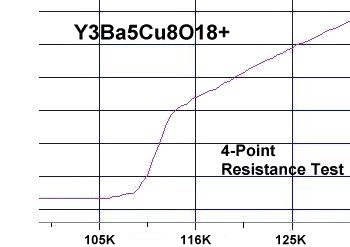
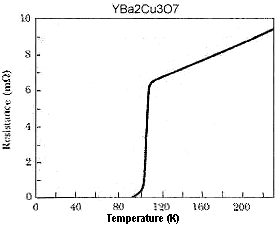
U l t r a Y B C O
104K Without Extra Elements




Superconductors.ORG herein reports the critical transition temperature (Tc) of the industrial superconductor YBCO (YBa2Cu3O7) has been successfuly increased from 91K to over 100K by reformulating to Y3Ba5Cu8O18+. No new elements were added.
Y358 - dubbed "Ultra YBCO" - is a novel intergrowth incorporating two different types of planar weight disparity (PWD) and a larger unit cell (around 31.2Å). The target structure, shown below left, is colinear and does not incorporate branching of the CuO2 chains, as occurs in the Y124 and Y247 structure types.
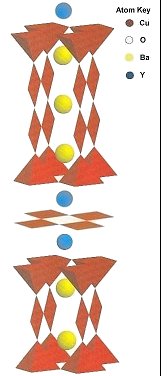 |
The above left plot shows a resistance-vs-temperature graph of the new material alongside standard YBCO. A total of eight R-T tests were performed. The two plots with the highest and lowest Tc's were discarded. The remaining six were then averaged, producing a mean Tc of 104 Kelvin. As can be seen, Y358 displays a resistive phase transition very similar to standard YBCO. (The resistance drop appears broader, due to an expanded temperature scale.) Empirical research has shown that two things are required to increase Tc in a layered copper-oxide:(1.) Increase the unit cell size to 16 metal layers, which has been found to be near optimal. (2.) Establish or increase planar weight disparity between alternating insulating layers or between alternating CuO2 planes. In this instance PWD was applied to both. Normally, intermixing PWD types within the same unit cell depresses Tc. However, a recent Pb-based discovery showed a Tc improvement when both the insulating layers and the CuO2 planes received planar weight adjustments. This was the precedent - and the impetus - behind the synthesis of Y358. |
To determine the viability of applying PWD to a layered perovskite with copper chains, two 14-layer prototypes were synthesized. Y347 results when another yttrium atom and another copper atom are placed into the CuO2 planes of Y123 (below left). Y257 results when another barium atom and another copper atom are placed into the insulating layers of Y-123 (below right). When tested, Y347 and Y257 both displayed a 4 to 5 degree increase in Tc over Y123. Those results suggested that a 16-layer hybrid of the two PWD types might produce a Tc over 100K.
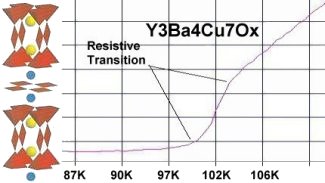
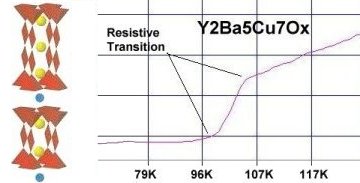
Other YBCO variants have also been discovered by Superconductors.ORG, but had limitations vis-a-vis standard YBCO. "Super YBCO" (Tc up to 106K) required the use of an expensive heavy rare earth oxide to synthesize. And "Enhanced YBCO", which includes calcium, has Tc near 96K. Ultra YBCO has a high volume fraction and should cost no more than standard YBCO to manufacture.
NOTE: It has since been discovered that the increase in Tc within this material is resistive only. The magnetic Tc does not change. To read more about this unusual behavior, click here.
Synthesis of the material was by the solid state reaction method. Stoichiometric amounts of the below precursors were mixed, pelletized at 70,000 psi and sintered for 11 hours at 890C. The pellet was then annealed for 10 hours at 500C in flowing O2.
 BACK to "News" page at Superconductors.ORG
BACK to "News" page at Superconductors.ORG